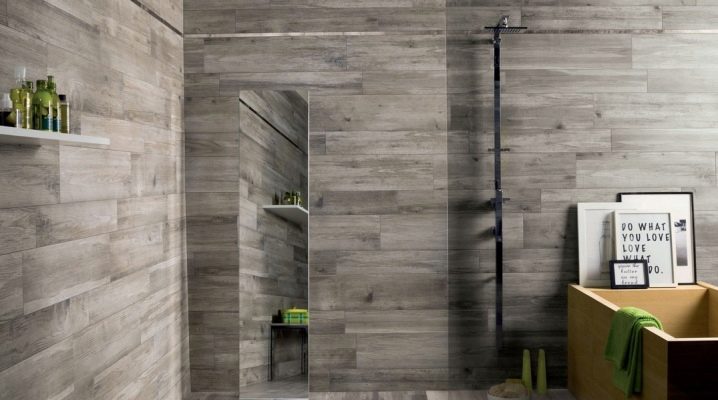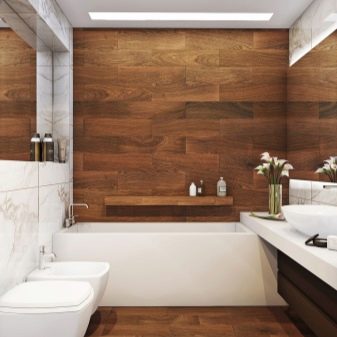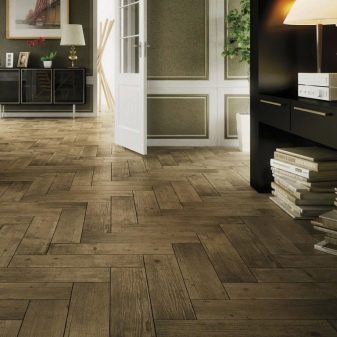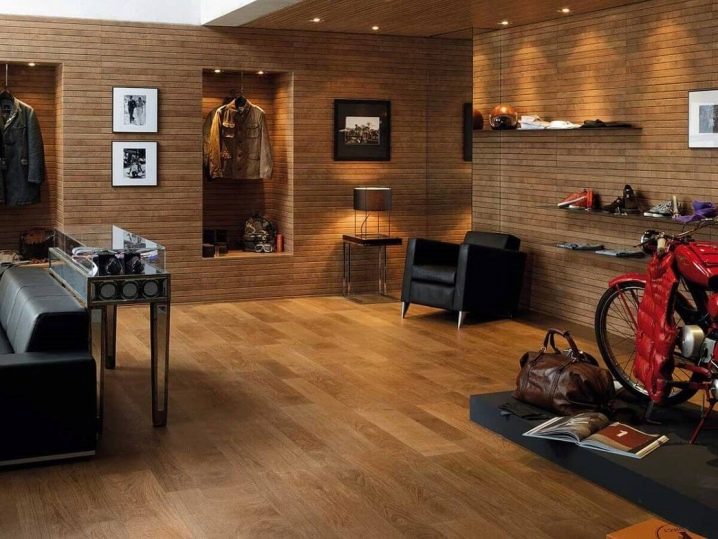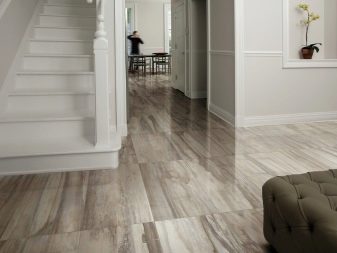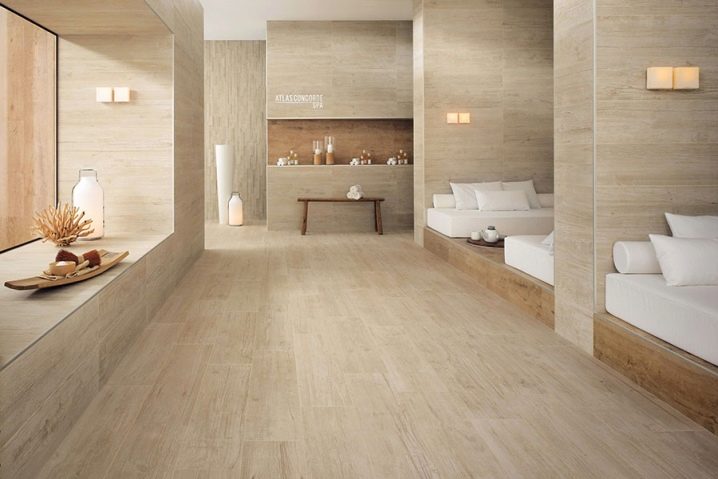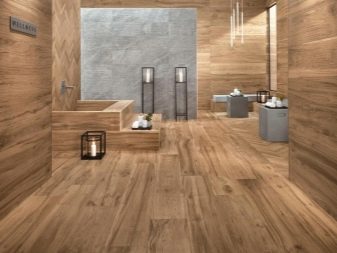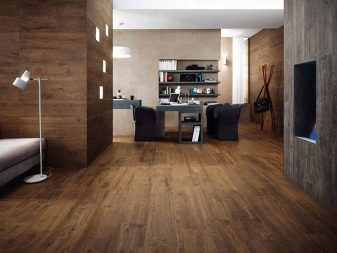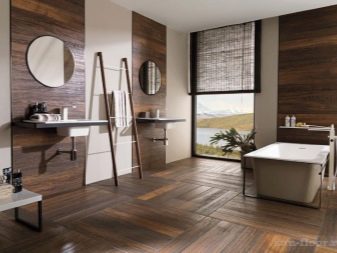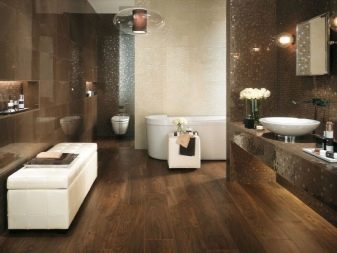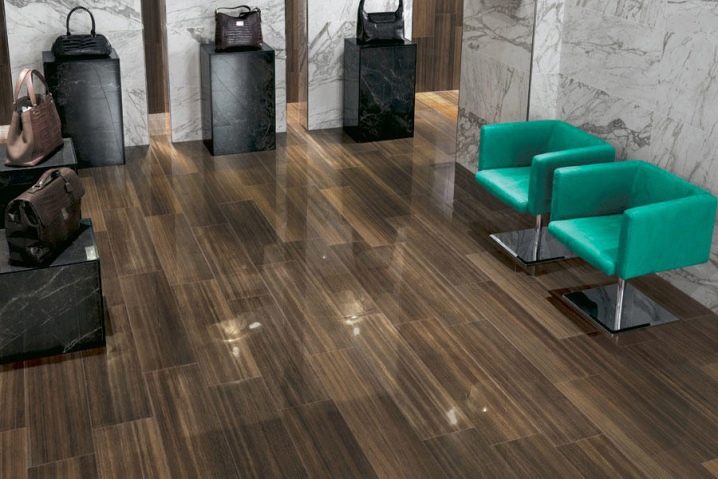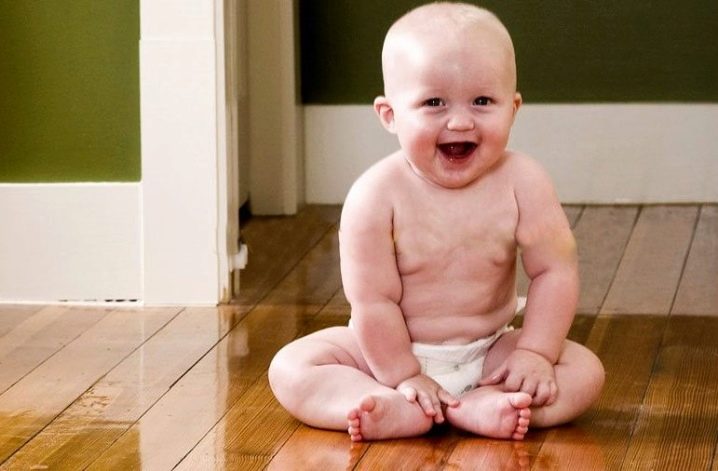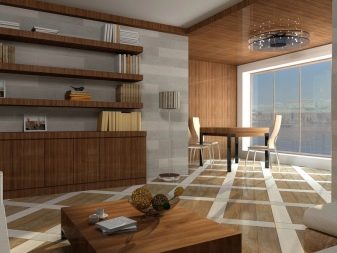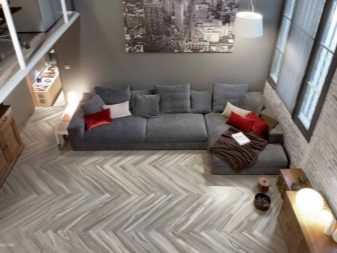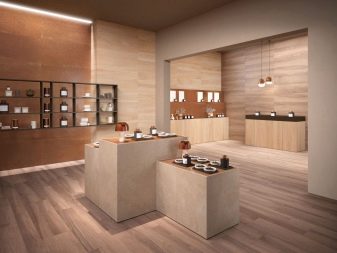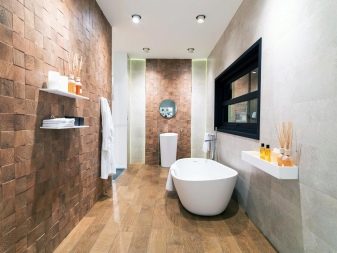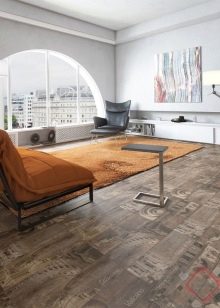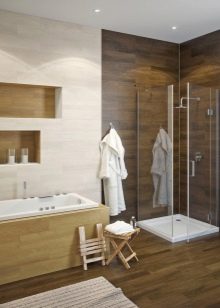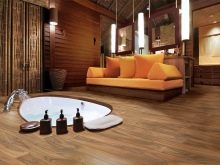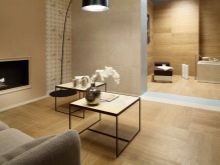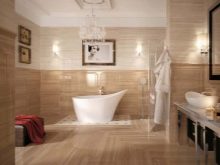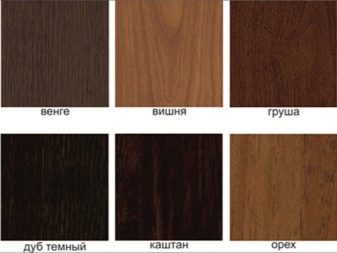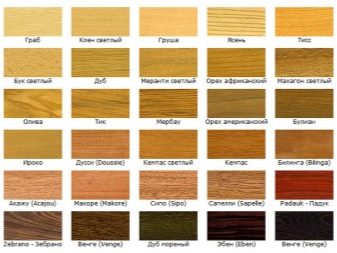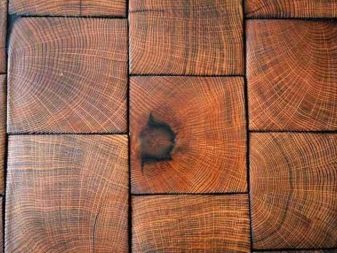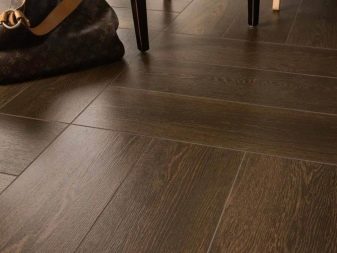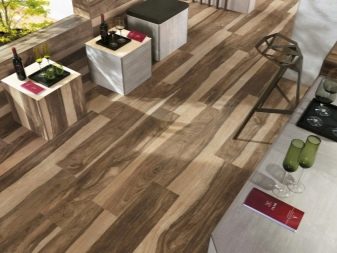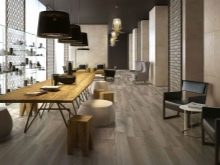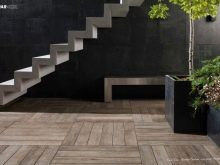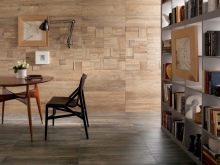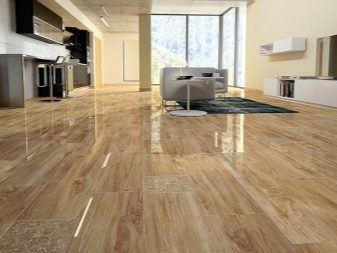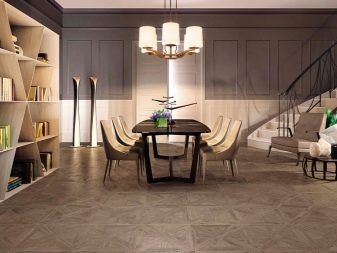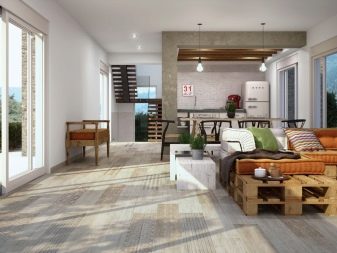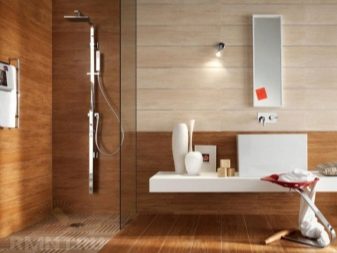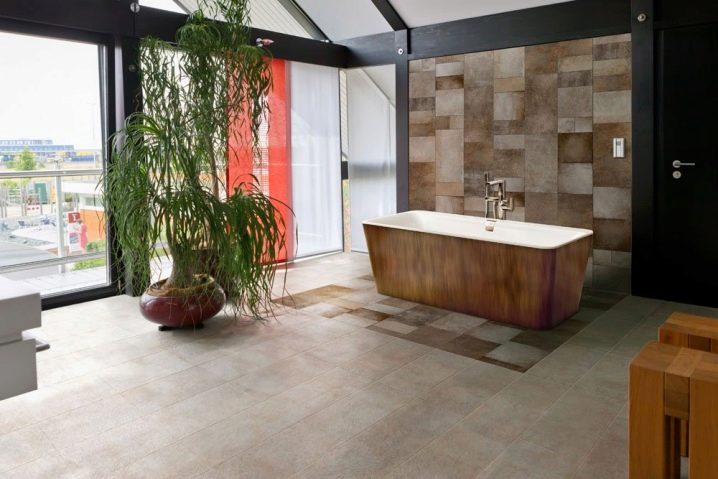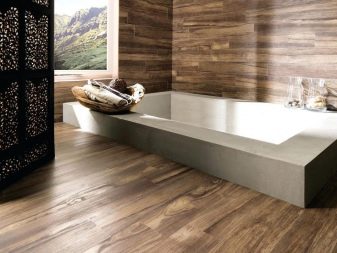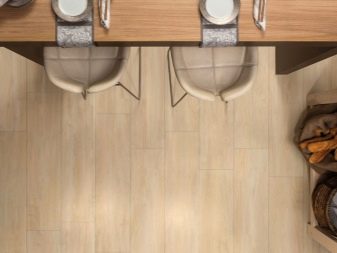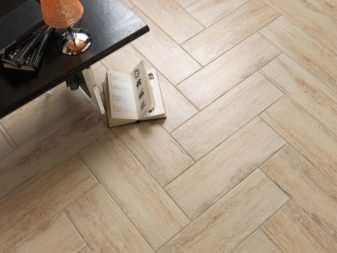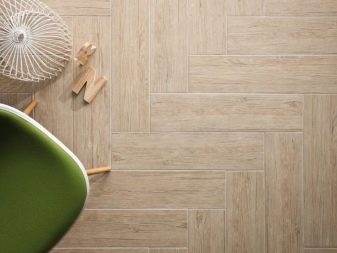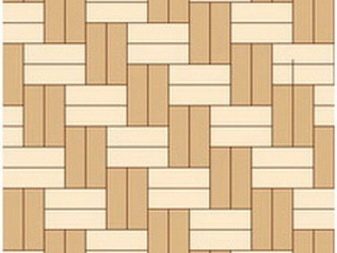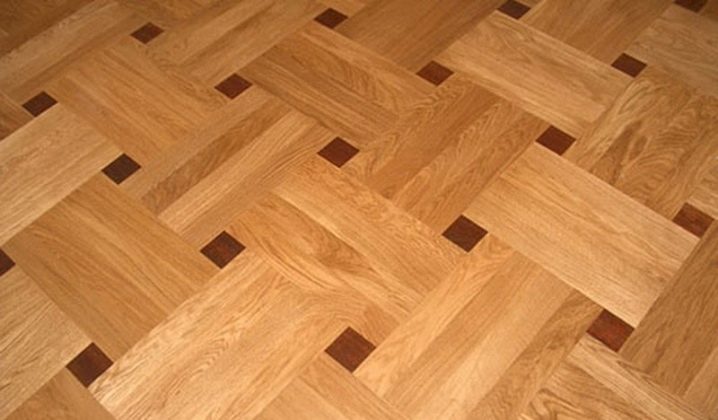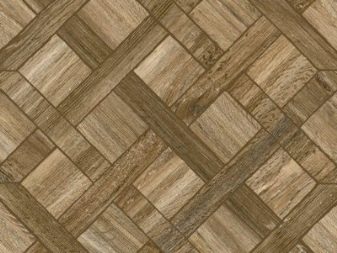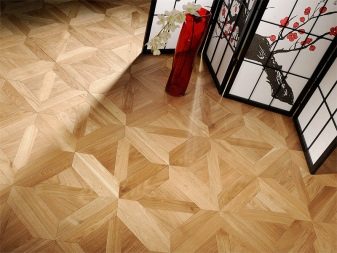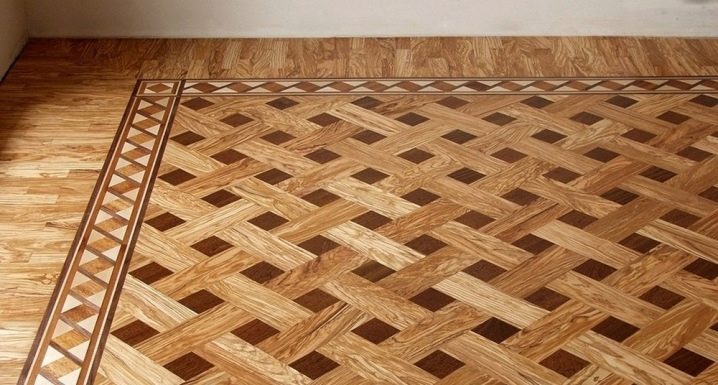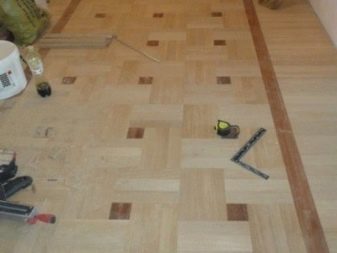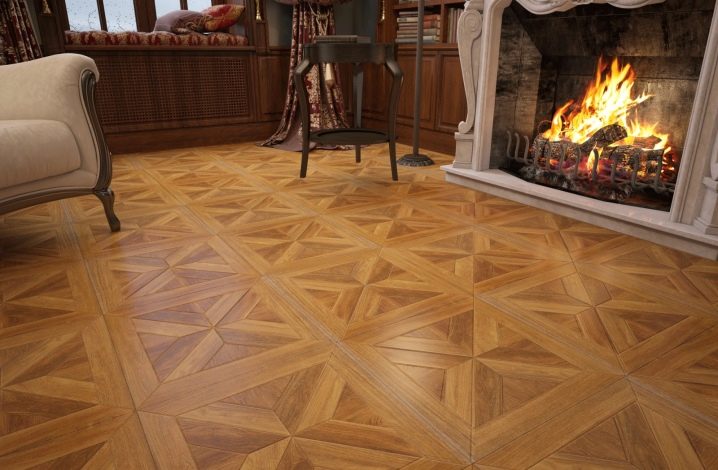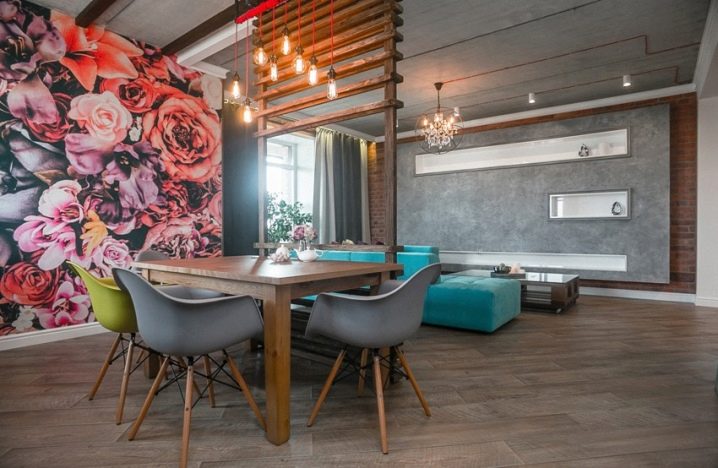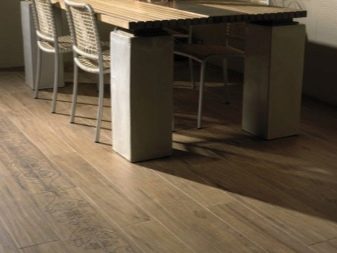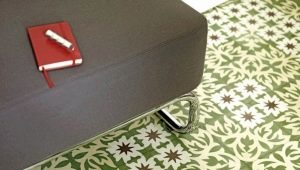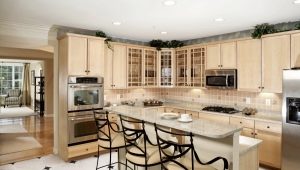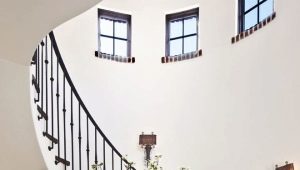Floor tiles under the tree: beautiful examples in the interior
Floor covering is an important component of repair. With the development of technology, much attention is paid to modern types of finishes, which are distinguished by high quality characteristics. Of the wide variety of products offered by trademarks for sale, floor tiles for wood are considered to be the most demanded facing material. We will understand its features.
Special features
This facing material imitates wood by means of texture and form. Today, such a coating is able to convey any species of wood so realistic that it is quite difficult to distinguish imitation at first sight.
The surface of the floor with such material can look monolithic or repeat parquet laying options. At the same time, several types of plates of different shades and sizes can be used in the work, creating intricate designs and decorative panels.
Tile itself is a cold material. Due to the unique texture and pattern, perception changes: floor ceramics under the tree exactly copies the texture and size of natural boards. Since wood is a warm material, visually the tile seems warm and pleasant. Especially the effect of associations is enhanced when combined with the “warm floor” system.
Externally, this is a smooth tile with a smooth surface, sometimes with a slight relief. Considering the needs of the modern buyer, trademarks develop different types of coating: the surface can be frosted, with anti-slip. Matte texture adds realism to the material, anti-slip effect prevents falling and injury.
Particularly noteworthy are the varieties with a 3D effect, which can visually add volume to both the individual elements of the coating and the entire room as a whole.
Advantages and disadvantages
The demand for floor tiles under the tree due to the mass of advantages. The main of them is the texture that imitates all kinds of wood, including valuable ones, of different types of wood: radial or tangential.
We list the main advantages.
- Due to the shade of the tile fits perfectly into any interior style regardless of the subject area. It is appropriate in classical, modern, ethnic, ecological styles and creative directions of design.
- This material has a wide range of natural shades, due to which the floor covering can be matched to the tone of doorways, doors, furniture or accessories.
- Tiles with the texture of wood can be used as a floor finish in any room, and especially in rooms with high humidity: sliding onto the surface of the water is excluded.
- From this material, you can lay out any pattern - from the floorboard to a variety of ornaments and decorative panels.
- Tiles under wood look expensive: this coating gives the impression of respectability, allows you to demonstrate the delicate taste of the owners of the house, their material well-being.
- The material differs in a variety of forms: on sale there are figured, square, narrow elongated, with cut corners. The plates are very large and very small.
- Floor tiles under the tree can significantly save the budget: it costs less than a parquet made of wood, while it is more durable than wood.
In addition to the advantages, there are disadvantages:
- Material is prone to spalling: you must handle it with care during transport and stacking. The coating gains strength after the tile adhesive dries.
- Without additional warming of the floor, the covering will be cold, therefore, carpets are often laid on the floor for warming.
Specifications
Floor tiles under the tree are often made of white or red clay, followed by firing. Facing material has a number of quality characteristics. He is assigned a class of durability and resistance to aggressive chemicals.
- The finish is highly durable, therefore it is suitable for finishing the floor in areas of high traffic: in the hallway, corridor, living room, kitchen and other rooms. The surface is not erased with time, due to the presence of a protective film.
- Wood floor tiles are resistant to moisture. It will easily replace the laminate, as it does not change its structure and degree of fixation to the base, even with prolonged stay of water on the surface.
- At the end of the finishing work, the material becomes durable: fixation eliminates the response to mechanical damage. During the operation period, the tile does not form chips, does not break, and for a long time retains the attractiveness of the original appearance.
.
- Due to the composition of such a lining is fireproof and environmentally friendly. During operation, it does not emit harmful substances into the air, so it can be used in the home of allergy sufferers.
- Easy to care. On such material soap streaks, drips or stains are not visible. The texture is developed according to a special technology, thanks to which the coating does not slip and does not rub off over the years.
- Due to the high level of chemical inertness, the lining is resistant to coloring organic matter and dirt. If necessary, paint, grease stains, gouache, felt-tip pens and other items for children's creativity can be removed from the surface.
- Floor tiles under the tree are durable: subject to the rules of operation, the service life of the coating can be up to 20 years or more. Due to the resistance to possible temperature difference, the structure will not collapse: crack formation and crumbling are unlikely
Kinds
All types of wood imitation tiles can be divided into three groups:
- ceramic;
- polyvinyl chloride;
- porcelain stoneware.
Tile is a classic version of the coating. Most often, its shape resembles board fragments.
The sizes are various and can be 59x59, 61x61, 30x30, 4x30, 19x12, 10x10, 22x90, 45x90, 15x90, 16x67, 15x120, 20x80, 20x40, 20x20, 15x60 cm. Narrow details are often used for framing wide tiles.
By type of surface are distinguished:
- glazed - the top layer of glaze has a decorative and protective function;
- with a glossy surface - tiles with a small reflective effect, can expand the space of the room and create depth;
- matt - provides less slip, gives the interior restraint and generosity;
- relief - with a rough and porous structure of the outer layer, non-slip, suitable for bathrooms and kitchens.
Porcelain stoneware - it is created under the influence of high temperatures and pressure, therefore it is more reliable than the ceramic analog and is much more expensive. The plates are of considerable thickness, degree of wear resistance and belong to a class with increased maneuverability.It is usually used for public buildings: airports, shopping centers. It can be used to finish the floors of halls in country houses. Depending on the shape, the dimensions of the fragments can be 15x15, 15x30, 20x20, 30x30, 30x45, 30x60, 40x40, 45x45, 60x60, 60x90, 40x120, 15x120, 30x120 cm.
To the inherent types of ceramics of the outer surface, porcelain stoneware also has a coated outer layer that combines the properties of matte and glossy.
Polyvinyl chloride tiles imitate wood materials as well as previous types. The product is a three-layer material consisting of the upper protective, middle vinyl and lower adhesive layers. During its installation, the protective film is removed, then the tile is glued to the base of the floor.
The material is elastic. More often, such raw materials are produced in the form of rectangular fragments, although, if necessary, square PVC tiles with imitation of parquet can be found on sale. Dimensions can be 32x65, 33x30, 40x40, 50x50, 60x60, 19x130, 32x65 cm.
Types of exterior surfaces correspond to the tiled group.
Colors and design
Color solutions of floor tiles under the tree adhere mainly to natural wood tones. The palette is many-sided, each its shade is designated by a separate name. For convenience of choice, each of them has a binding to a specific wood species.
One type of wood can have several shades, which allows you to choose the right tone as accurately as possible according to your preferences. For example, on sale you can find oak seventeen shades from light, bleached to wenge.
The range of shades includes ash, beech, light maple, walnut, iroko, cherry, mahogany and many others, including extremely rare and exotic breeds. The colors are all shades from light gray, beige to dark brown and black and gray. Some species give a reddish and brick tone, others have a yellowish tint.
Sometimes the main color of the wood on the fragment is diluted with white, so the die looks impressive. Black color is not used in its pure form: it looks nobler in combination with chocolate or gray.
The design of the tiles is varied. In addition to the main shade in each variety, manufacturers focus on texture, trying to convey it as accurately as possible. It can be a transition of several tones, imitation of aged wood, knots, interspersing other shades in the form of stripes, divorces. Ornaments are popular, among which the drawings on top of the main tone and the band patterns are especially interesting.
The materials easily convey the parquet and parquet flooring, demonstrating the beauty of natural shades.
An imitation of the bark of an old array looks stylish, plausibly conveying a play of light and dark tones.
Manufacturers
On the modern market of floor tiles with imitation of wood there are a lot of companies. In particular demand among buyers enjoys tile manufacturers from Russia, Italy, Spain.
Among the popular brands include:
- Far ctramiche - Italian manufacturer, offering to the attention of customers premium materials with high performance.
- "Rinaldi" - Italian brand engaged in the production of porcelain stoneware with a matte glazed surface in beige and brown tones.
- "Shakhty tile" - a manufacturer of high-quality material for wood, which is distinguished not only by its texture, but also by the presence of a plant pattern on the surface in the same range with the main background.
- Windsor - a company producing ceramic granite with a surface,structured under the parquet tree and a small relief (roughness).
The best choice is the purchase of tiles of Italian or Spanish production.
Reviews note the need for calibration of domestic tiles.
Tips for choosing
The choice of floor tiles under the tree is subject to the preferences of the buyer and the chosen idea of design. For chemical resistance, it is preferable to choose for the floor tile A and B classes. In the first case, the surface does not change under the influence of chemicals. In the second, the changes will be minor.
If a PEI IV characteristic is specified upon purchase, such material will be durable. It is also possible to purchase tile with a wear class PEI III (not recommended below).
If it is important to buy tiles with anti-skid, you should pay attention to the indicator R11 - R13. This material is designed for daily use and is used for industrial facilities. It is great for rooms with high humidity. Marking with a lower index indicates that the roughness effect is smaller.
What matters is the choice of color: it must fit into the style.
Light colors are appropriate for modern interiors, warm beige tones are suitable for eco-directions, varieties with a bleached gray color harmoniously fit into vintage interiors.
It is good if the selected color will be related to furniture, while differing from it by two or three tones. It is undesirable for the color to fully coincide with the furniture, even if it is based on elements of a wooden frame. This creates the feeling that the furniture has grown into the floor and the interior is no longer expressive.
Since such material is placed more often without seams, it is worth taking care of a good glue. In choosing it is important to take into account the geometry, checking the batch number. It is necessary to evaluate the shade of the material of each package.: it should not be different, it will spoil the appearance of the flooring. If you plan to buy companion tiles, compare the length and width for the identity of the side faces. This is especially important for styling according to the braided method.
Consider the purpose of the room: in the hallway, the corridor would be appropriate to a more concise method of laying, so it is more expedient to purchase wide fragments. This will facilitate and care for the surface.For living rooms, study rooms, tile of various sizes will be the best solution. It will give elegance to even the most boring interior.
Styling options
Laying floor tiles under the tree is varied and depends on the shape of the fragments, their size and color. Conventionally, all methods can be called parquet, as when laying using the same techniques. Consider the basic techniques.
Deck
This package has a second name: "to the break". When laying the fragments are fixed on 1/5 or 1/6 of the length of the tile. It is important to observe the initially chosen amount of displacement throughout the work. Changing the shift will break the integrity of the pattern. This type of lining is appropriate for the classic straight and diagonal arrangement of fragments.
Herringbone
It is an alternative to deck method. Implies straight and diagonal styling. The method is remarkable in that it is possible to use material with a different wood texture in the work: for example, it can combine two different tones or patterns.
You can stack fragments in one, two or three narrow tiles. In this case, you can vary the pattern of flooring.This may be a diagonal packing in 2 strips, 1 to 3, straight in 2 strips, straight with different lengths of strips.
Chess
This package is called "checkers". In fact, this is a kind of chessboard of square fragments. A distinctive feature of this method is the use of different shapes in the packing of fragments.
For example, you can use large square details in your work, combining them in a specific pattern with narrow slats that make up squares of similar size. The direction of the narrow slats may be different, which gives originality to the pattern of the coating. If conceived by design - in the decoration using framing fragments.
Network
One of the most interesting ways of laying floor tiles under the tree. It looks original, reproduces exactly the imitation of parquet. It is a laying of fragments on the principle of plain weave fabric. It looks stylish, does not need additional decoration.
At the same time for greater similarity with the pattern of parquet in the work, you can use fragments of different sizes and shapes (“Swedish” braid). The method is more time consuming, but the result looks much more interesting than simple board layouts.
Versailles
Externally, the method of laying resembles the interlacing of rectangular tiles of small size, enclosed in square frames. Several types of styling are mixed in the technique, often factory parts cut at the corners are involved in it. Due to the different direction of the texture, the floor looks elegant.
One of the varieties of this method is "Pavlovskaya braided."
The difference lies in the fact that in the first case two types of material for wood of different shades are taken for work, and in Pavlovsk the material of the same tone is used in the work.
Frame
It looks spectacular, but it requires maximum preparation, taking into account the exact calculation. Carry it out of narrow slats, which can be of different sizes to comply with the pattern. Outwardly, these are more often squares that have frames of a different color. The direction of the stripes may be perpendicular. The frame is usually made of a darker material.
Well
One of the difficult ways of laying, with spectacular and voluminous. Outwardly, this is an alternative to braids, only the floor cloth is made up of fragments, in the center of which there are small squares.More often they are distinguished by a darker surface tone, symbolizing the bottom of the well. Frame the squares with light tiles by weaving.
In this paper, you can use fragments of three shades.
Beautiful examples
To appreciate how beautiful a floor can be from a tile under a tree, you can refer to the examples provided by the photo gallery.
Diagonal stacking under the tree looks stylish without the complexity of the picture and fits well in the style of the loft.
Floor tiles are appropriate in the living room interior with a fireplace: it gives the space a note of warmth and home comfort.
Another example of modern industrial style. Laying on the diagonal without too much decoration creates a harmonious atmosphere of the room, while the overall interior looks stylish and unusual.
A classic example of laying tiles under a tree with a shift. Great solution for the floor in the hallway. Tile support are panels of identical tone.
Using tiles with an ornament on a woody background is a good design solution for the living room. Due to the light shade, the atmosphere of the room is light.
Read more about how to choose a tile under the tree and use it in the interior,You will learn from the following video.
